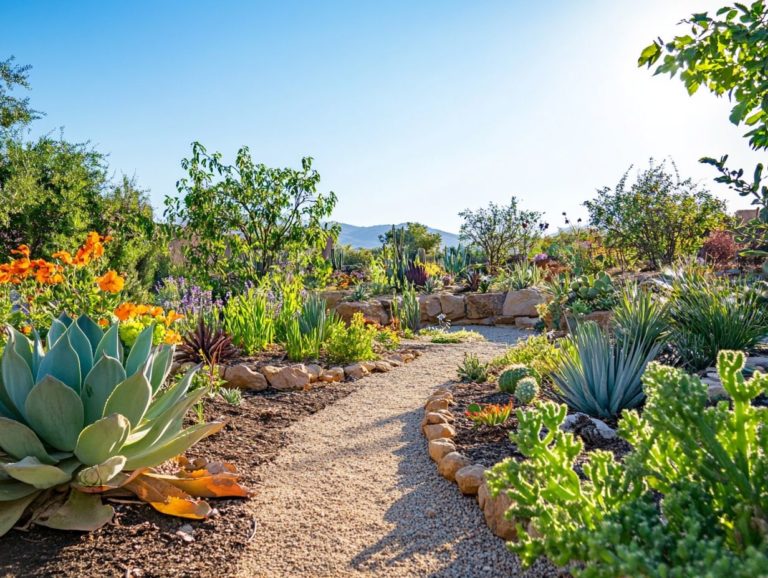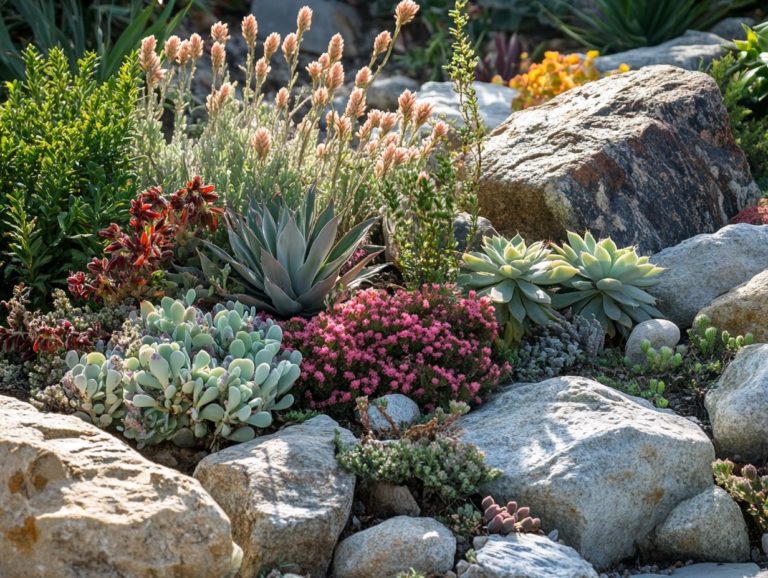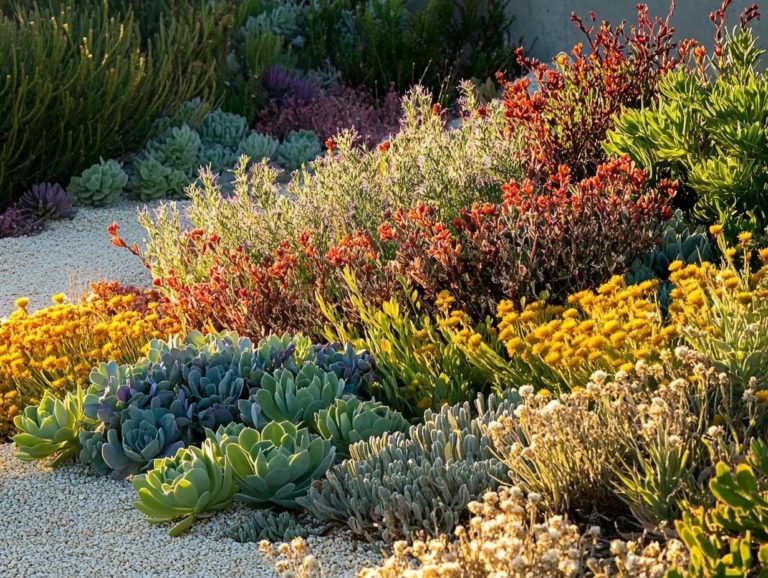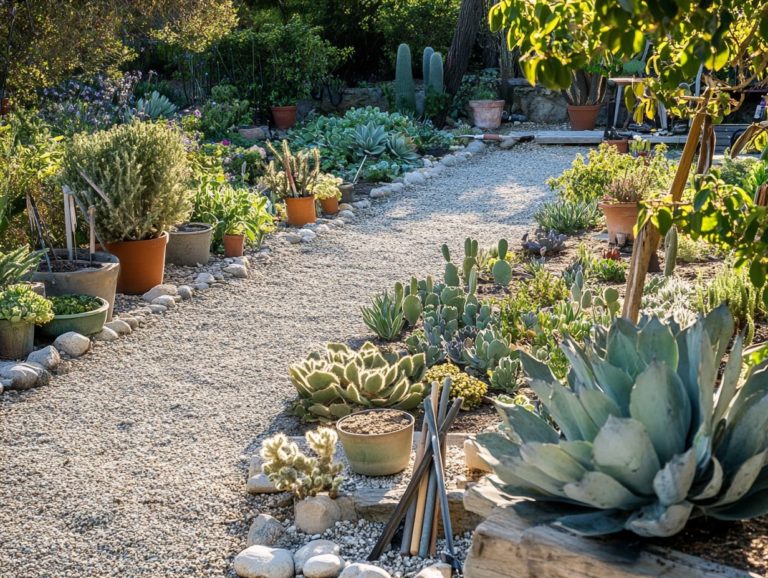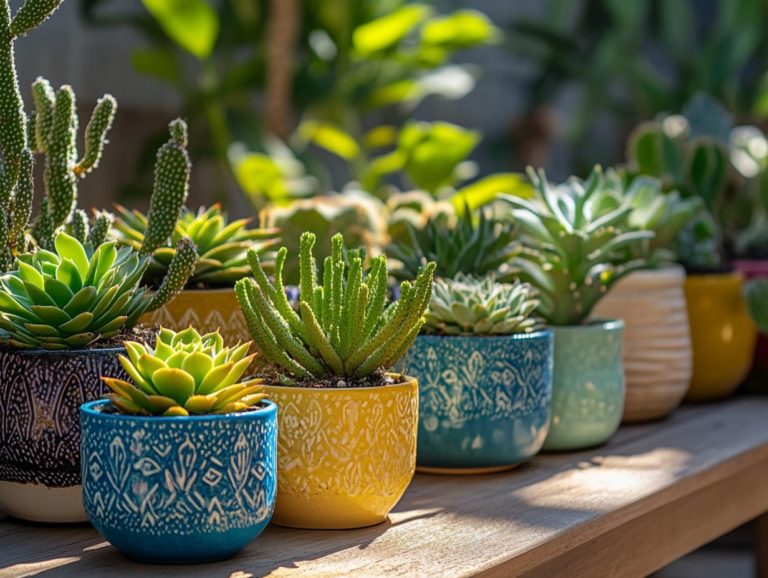Cacti Varieties Perfect for Drought Gardens
If you re aiming to enhance your garden with resilience and distinctive beauty, drought-tolerant cacti are your ideal choice! Not only are they low-maintenance, but they also offer a stunning array of shapes, sizes, and colors that can truly elevate any landscape.
Dive into the world of cacti that thrive in arid environments, from the majestic Saguaro to the charming Old Man Cactus. You ll discover valuable tips on their benefits, common growing mistakes to avoid, and ways to integrate them seamlessly into your garden design.
Are you ready to embark on this exciting journey?
Contents
- Key Takeaways:
- 1. Prickly Pear Cactus
- 2. Barrel Cactus
- 3. Saguaro Cactus
- 4. Organ Pipe Cactus
- 5. Hedgehog Cactus
- 6. Agave
- 7. Aloe Vera
- 8. Yucca
- 9. Dragon Fruit Cactus
- 10. Easter Lily Cactus
- 11. Pincushion Cactus
- 12. Fishhook Cactus
- 13. Golden Barrel Cactus
- 14. Zebra Cactus
- 15. Old Man Cactus
- What Are the Benefits of Having Drought-Tolerant Cacti in Your Garden?
- What Are the Common Mistakes to Avoid When Growing Drought-Tolerant Cacti?
- How Can You Incorporate Drought-Tolerant Cacti in Your Landscape Design?
- What Are the Best Soil and Watering Practices for Drought-Tolerant Cacti?
- How Can Drought-Tolerant Cacti Survive Extreme Weather Conditions?
- Frequently Asked Questions
- Why Are Cacti Perfect for Drought Gardens?
- What Are Some Popular Cacti Varieties for Drought Gardens?
- How Often Should You Water Cacti Varieties for Drought Gardens?
- Are There Special Care Instructions for Cacti Varieties in Drought Gardens?
- Can Cacti Varieties for Drought Gardens Be Grown Indoors?
- What Are Other Benefits of Cacti Varieties for Drought Gardens?
Key Takeaways:
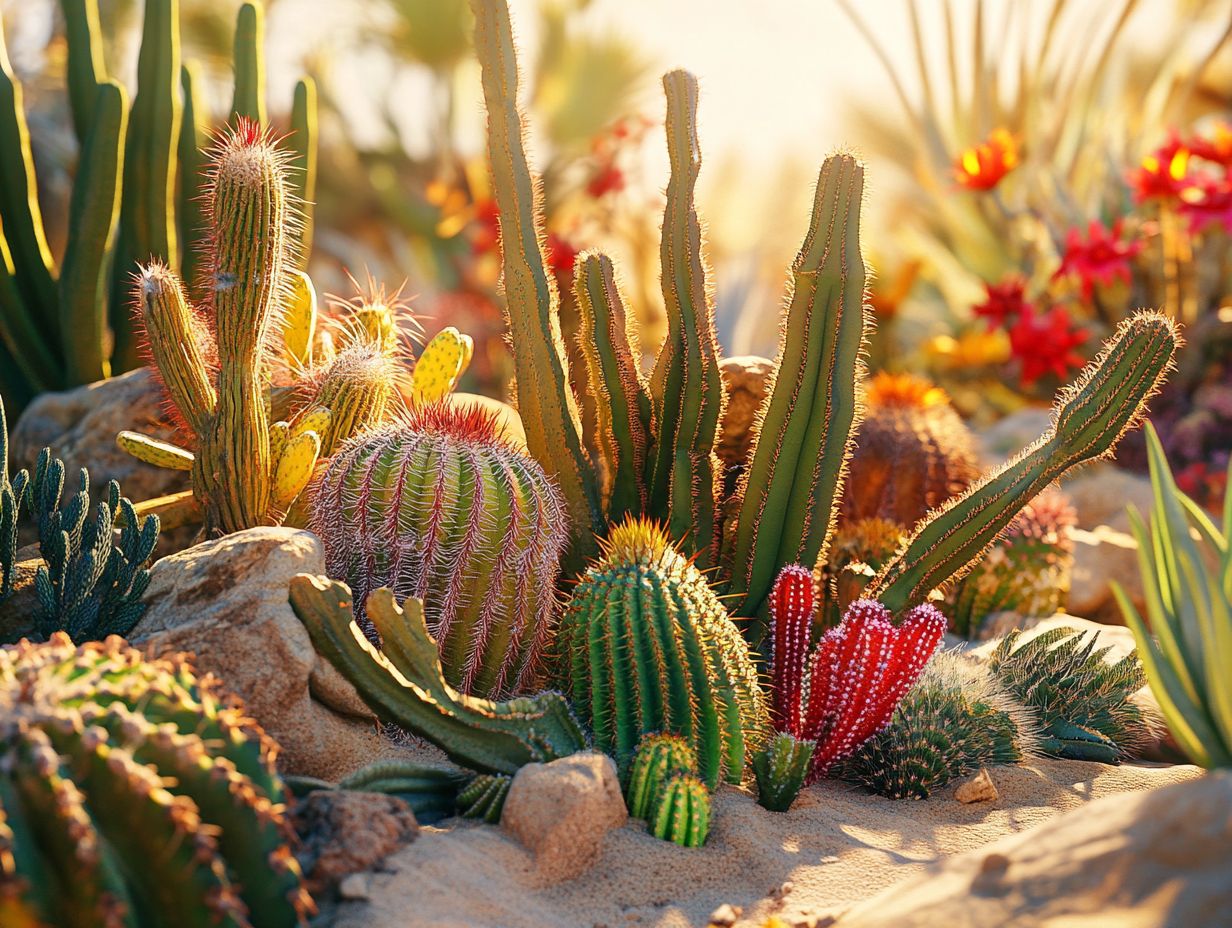
- Drought-tolerant cacti like prickly pear and barrel cactus are perfect for gardens in dry climates.
- Incorporate different varieties, such as organ pipe and fishhook cactus, to add visual interest to your landscape design.
- Proper soil, watering practices, and protection from extreme weather are crucial for the survival of drought-tolerant cacti.
1. Prickly Pear Cactus
The Prickly Pear Cactus, hailing from the sun-soaked landscapes of Arizona, is a standout choice if you’re looking for vibrant colors and unique flowering patterns. This drought-tolerant plant thrives in full sun and well-drained soil, making it an ideal addition to your garden.
Not only does it enhance the beauty of outdoor spaces, but it also embodies sustainable gardening practices, showcasing remarkable resilience against extreme weather.
You ll find various species of Prickly Pear, such as Opuntia ficus-indica and Opuntia engelmannii, each with its captivating growth habits and a spectrum of bloom colors, from bright yellow to deep magenta. These plants prefer sandy or rocky soils and require minimal watering once established, making them a perfect fit for your gardening projects with little water.
Just be mindful to protect them from frost, as they thrive best in warm climates.
Expect their stunning blossoms to emerge in late spring, attracting pollinators and boosting biodiversity. When integrated thoughtfully into your garden design, Prickly Pears can serve as eye-catching focal points or form informal hedges, adding texture and visual intrigue throughout the seasons.
2. Barrel Cactus
The Barrel Cactus, a striking succulent that graces the deserts of Arizona, is renowned for its unique cylindrical form and vibrant blooms! This plant is a favorite among gardeners seeking low-maintenance, drought-tolerant options that thrive in arid climates.
This remarkable plant has different subspecies, each offering distinct traits that cater to various gardening styles. For example, the Golden Barrel Cactus, with its brilliant yellow spines, can reach heights of up to three feet and flourishes in USDA hardiness zones 9-11. The Fishhook Barrel Cactus, known for its distinctive hooked spines, is perfect for those in slightly cooler temperatures.
For care, provide well-drained soil a gritty mix is usually best. Water sparingly, allowing the substrate to dry completely between watering sessions. Proper sunlight exposure is also crucial; aim for bright but indirect light to encourage those stunning, show-stopping flowers.
3. Saguaro Cactus
The Saguaro Cactus, an iconic emblem of the American Southwest especially in Arizona stands tall and majestic, creating a stunning focal point within the desert landscape. This drought-tolerant wonder elevates the aesthetics of your garden and provides vital habitats for various wildlife!
With the capability to reach heights of up to 40 feet and a lifespan that can exceed 150 years, it becomes an intriguing subject for anyone passionate about native flora. During its flowering stages in late spring, the Saguaro dazzles with spectacular white blooms, drawing in pollinators like the harmless Gila monster and an array of birds.
When incorporating this unique cactus into your landscaping, pay attention to its spacing and sunlight needs to ensure it thrives. Regular care and maintenance such as occasional watering and protection from frost will keep your Saguaro healthy, allowing it to flourish while contributing to the biodiversity of arid regions.
Start your cactus garden today!
4. Organ Pipe Cactus
The Organ Pipe Cactus, a true gem of the Sonoran Desert in Arizona, stands out with its tall, upright growth and multiple stems. It is a great choice for gardens or landscaping projects focused on drought-tolerant plants.
This remarkable succulent thrives in full sun and well-drained soils, perfectly suited for life in arid environments. Its vibrant, night-blooming flowers not only enhance aesthetic appeal but also help local wildlife.
You can propagate this stunning species through seed sowing or by carefully taking cuttings from established plants, allowing you to share its beauty with others. With its striking architectural form and resilience, the Organ Pipe Cactus is a favored selection for xeriscaping, a landscaping method that conserves water, which aims to create sustainable, visually captivating outdoor spaces with cactus and succulent varieties.
5. Hedgehog Cactus
The Hedgehog Cactus, with its vibrant and colorful flowers, presents a delightful option for your garden. This charming succulent flourishes in Arizona’s arid regions, making it perfect for those who value drought-tolerant plants that inject color and character into outdoor spaces.
Several species of Hedgehog Cactus exist, such as the well-loved Echinocereus engelmannii and Echinocereus rigidissimus. Each showcases unique blossoms that bloom in stunning shades of pink, purple, and red. The flowering season typically spans from late spring to early summer, offering a breathtaking visual feast.
For optimal growth, these cacti thrive in well-drained soil, require minimal watering, and bask in plenty of full sun. Incorporating Hedgehog Cacti into your landscape design can elevate the texture and vibrancy of your space, whether you choose to feature them as striking focal points in rock gardens or integrate them into a desert-themed arrangement alongside other succulents and xeriscaping elements.
6. Agave
Agave, a resilient succulent hailing from the arid landscapes of Arizona, is celebrated for its captivating rosette shape and architectural elegance. It s no wonder this plant appeals to gardeners seeking low-maintenance, drought-tolerant options that infuse their garden designs with dramatic flair.
This remarkable genus boasts a plethora of species, each showcasing distinct textures and colors that can elevate any landscaping project. From the bold, spiky edges of Agave americana to the soft, soothing blue tones of Agave tequilana, there s an Agave variety that perfectly aligns with your aesthetic preferences.
Caring for these sturdy succulents is straightforward. Prioritize well-draining soil, provide moderate watering, and ensure plenty of sunlight. This approach allows them to thrive in various conditions. Their ability to serve as a stunning focal point or seamlessly complement surrounding plants makes them an exceptional choice for crafting visually dynamic outdoor spaces.
7. Aloe Vera
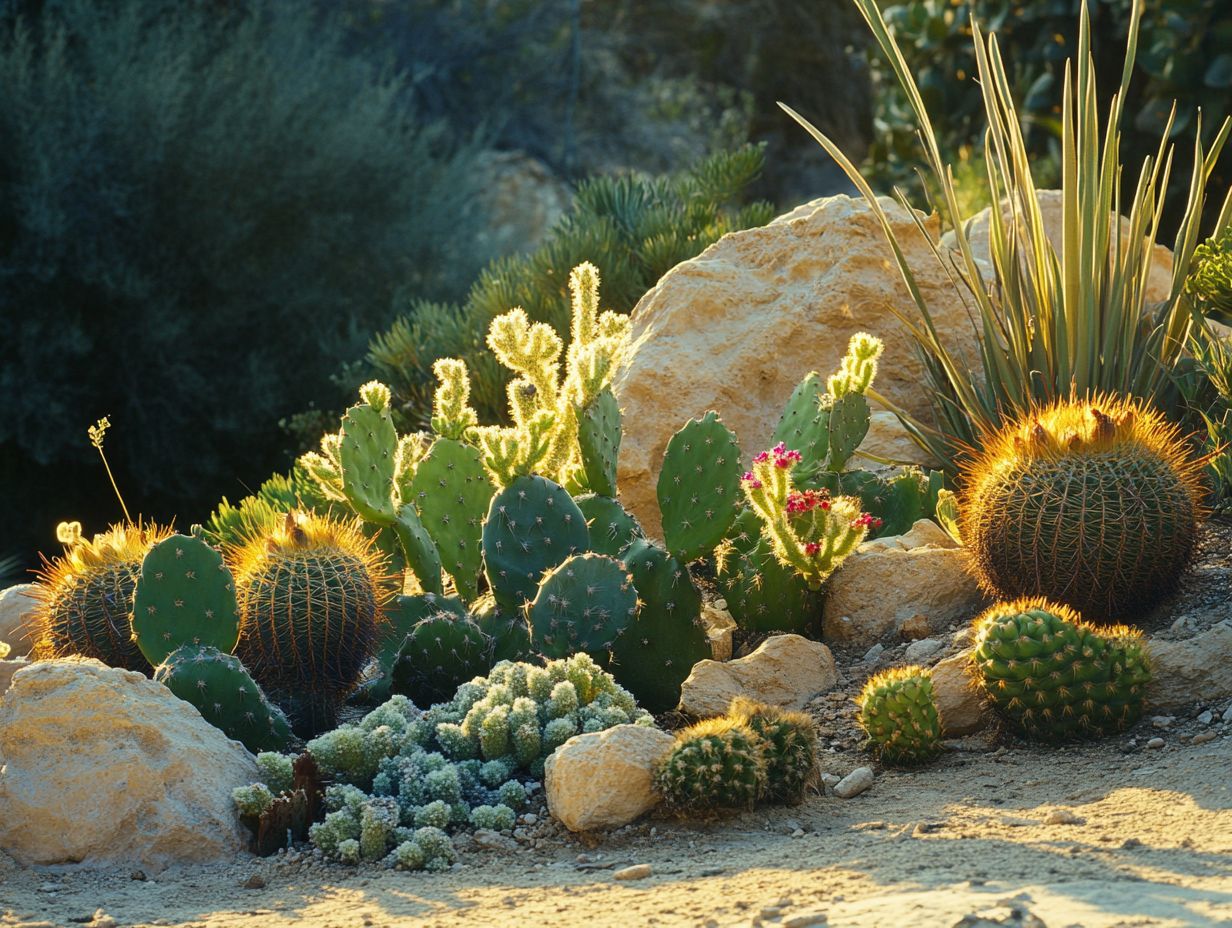
Aloe Vera, that renowned succulent celebrated for its remarkable medicinal properties, thrives effortlessly in dry environments. It s a superb choice for gardens focused on sustainability and drought tolerance, especially in water-conscious places like Arizona.
This amazing plant stores water in its thick leaves, making it a survivor in dry conditions. With just a bit of attention think bright, indirect sunlight and well-draining soil you ll see Aloe Vera flourish beautifully.
You can creatively incorporate this versatile gem into various design schemes. Whether you choose to showcase it as a striking centerpiece in pots or group it in a charming rock garden, the options are endless. Opting for terracotta or decorative ceramic pots can elevate the aesthetic appeal, and placing them near south-facing windows or outdoor patios ensures they soak up plenty of sunlight.
Adding Aloe Vera not only enhances the beauty of your landscape but also brings health benefits, making it a savvy choice for eco-conscious gardening and adding to the varieties of plants in your garden.
8. Yucca
Yucca is a drought-tolerant marvel from the Southwestern US, especially Arizona. It captures attention with its sword-like leaves and stunning flower spikes. This makes it a top choice for low-maintenance gardens that blend beauty and resilience.
Among the various types of yucca, the popular Yucca filamentosa and majestic Yucca rostrata stand out. These hardy plants flourish in well-draining soil and need minimal watering once settled. Their bold visual impact enhances outdoor spaces and adds unique architectural quality to garden design.
When you place yucca along gravel pathways or pair it with other desert flora, it creates captivating focal points that harmonize beautifully with the landscape. They attract pollinators, adding ecological value to your garden and enhancing your outdoor experience.
9. Dragon Fruit Cactus
Picture yourself growing the Dragon Fruit Cactus, with its vibrant fruits and breathtaking nocturnal flowers. It s an exotic gem for your garden, especially in Arizona. This remarkable plant thrives with little water and is low-maintenance, blending beauty with edibility.
This plant not only endures intense heat but also requires minimal watering ideal for sustainable gardening. With upright stems and a sprawling growth habit, it offers year-round visual interest, particularly in full sun.
As it matures, it rewards you with striking white flowers that bloom at night, inviting nocturnal pollinators like moths and other beneficial native plants to your garden.
The Dragon Fruit Cactus isn’t just beautiful; it plays a vital role in edible landscaping. It produces sweet, nutritious fruits rich in vitamins and antioxidants. You can enjoy them fresh or use them in various culinary creations, enhancing both your dishes and gardening experience. Don t miss the chance to add this stunning plant to your garden!
10. Easter Lily Cactus
The Easter Lily Cactus offers breathtaking flowers that bloom in spring, making it a charming addition to your Arizona garden. This succulent not only enchants the eyes but also boasts low-maintenance, drought-tolerant qualities that many gardeners desire in Arizona’s dry climate.
To thrive, this plant prefers well-drained soil and bright, indirect sunlight. Moderate watering is essential; allow the soil to dry out between waterings to prevent root rot. During blooming season, you’ll be rewarded with vibrant, trumpet-shaped blossoms that transform simple landscapes into stunning visual treats, especially when paired with other flowering succulents.
If you want to incorporate the cactus into your garden design, consider placing it among rocks or in a striking succulent arrangement. Its unique shape and striking flowers enhance various outdoor aesthetics, especially when combined with cacti like the Golden Barrel or Silver Torch.
11. Pincushion Cactus
The Pincushion Cactus, a small yet enchanting succulent from Arizona, is a delightful addition to any low-maintenance garden that values drought-tolerant qualities and visual appeal. Its unique shape and delicate flowers make it a true standout among native plants.
This charming plant is part of the broader cactus family, which includes various species, each with distinctive traits. For instance, the Eisenhower Pincushion dazzles with vibrant yellow blooms, while Mammillaria dioica showcases stunning pink flowers, adding color to rocky landscapes, perfect for garden design.
When incorporating these beauties, provide well-drained soil and ample sunshine to ensure they thrive without overwatering. Their compact size allows endless creative possibilities, whether nestled among larger desert plants or used to create striking borders along pathways with other low-maintenance plants.
With minimal effort, enhance your garden’s overall aesthetic and enjoy the captivating charm of the Pincushion Cactus, especially when combined with the Golden Barrel Cactus or Blue Flame Cactus.
12. Fishhook Cactus
The Fishhook Cactus, with its distinctive hooked spines, is a captivating succulent that thrives in Arizona’s arid landscapes. This makes it a valuable asset for your drought-tolerant garden or desert landscaping. Try mixing in other species like Strawberry Hedgehog for an exciting twist!
With its unique and spiky appearance, this cactus serves as a striking focal point. It beautifully complements various native plants, enhancing the overall aesthetic of your outdoor space. If you love low-maintenance plants, you’ll appreciate that it requires minimal water. It thrives best in well-drained soil and abundant sunlight, making it a great choice for container gardening.
When you plant the Fishhook Cactus alongside other succulents or ornamental stones, you can transform a simple garden into a stunning desert oasis. This appeals to both seasoned gardeners and those just starting their horticultural journey. Mix it with Golden Barrel or Old Man Cactus for unique textures!
13. Golden Barrel Cactus
The Golden Barrel Cactus, with its enchanting spherical shape and striking golden spines, captivates as a standout succulent. It thrives effortlessly in Arizona’s arid desert environment and is a favored choice for low-maintenance gardens that prioritize drought tolerance and visual appeal, especially when paired with prickly pear.
To ensure the health and vitality of this remarkable plant, you must provide well-draining soil preferably a blend known as cactus mix. Excess moisture is the enemy, so embrace a soak-and-dry watering routine. Allow the soil to dry out completely between waterings, usually every two to three weeks during the growing season.
Position this cactus in a sunny location to enhance its growth and preserve its vibrant coloration. This transforms it into a striking ornamental asset in your indoor or outdoor spaces, perfect for creating a stunning garden design.
14. Zebra Cactus
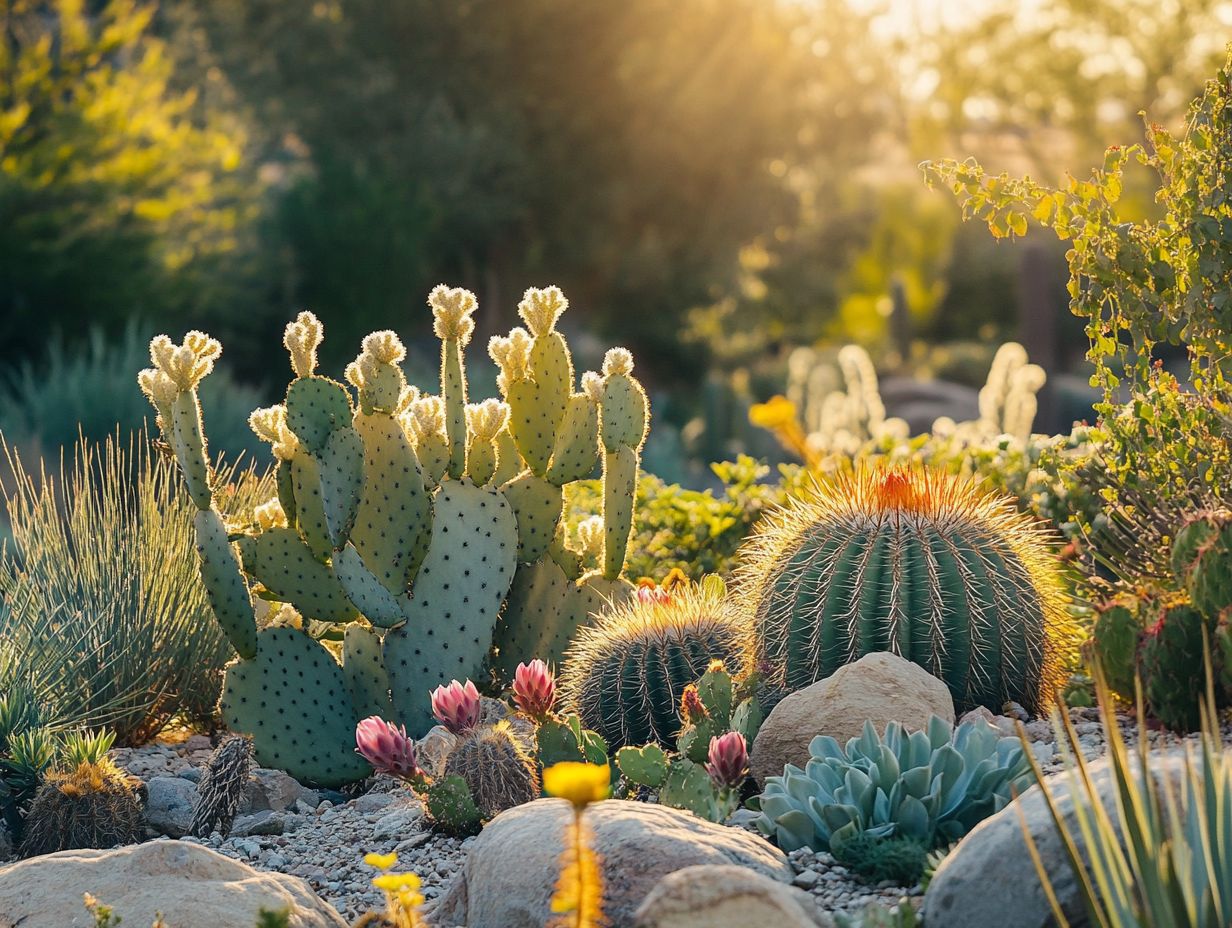
The Zebra Cactus, with its distinctive striped appearance, is a low-maintenance succulent that adds striking visual flair to your garden while thriving in drought conditions. It s the perfect choice for Arizona’s dry climate, especially when planted alongside other drought-tolerant varieties.
This resilient plant thrives in well-draining soil and loves a sunny spot. Let the soil dry out between waterings; overwatering can lead to rot, and you don t want that. Use some organic fertilizer during the growing season for added nutrients.
In terms of garden design, the Zebra Cactus stands out beautifully as a focal point in rock gardens or desert landscapes. It offers both texture and contrast with its bold stripes. It’s also a great candidate for containers on your patio.
Its adaptability means it flourishes in containers, making it a fantastic addition to your patio or balcony while demanding minimal care. Consider using a cactus mix for optimal growth in these settings.
15. Old Man Cactus
The Old Man Cactus, with its long white hairs and striking appearance, is a standout succulent from Arizona. It’s perfect for your drought-tolerant garden, providing a low-maintenance yet visually captivating option that pairs well with Golden Barrel Cactus.
This delightful cactus thrives in arid conditions and boasts a fuzzy texture. It brings to mind the whimsical image of an old man’s beard, offering both aesthetic intrigue and ecological benefits. If you re considering adding it to your garden, easily pair it with vibrant flowering succulents like the Candelabra Cactus or Blue Flame. You can also integrate it into rock gardens, where its playful silhouette enhances the landscape.
This resilient plant demands minimal watering and prefers well-draining soil. This makes it ideal for busy lives. With the right amount of sunlight and occasional fertilizer during the growing season, you can expect it to flourish. It adds unique character to your outdoor spaces and creates an inviting atmosphere.
Start your drought-tolerant garden today!
What Are the Benefits of Having Drought-Tolerant Cacti in Your Garden?
Incorporating drought-tolerant cacti into your garden offers a wealth of benefits, including reduced water usage and minimal maintenance. For a vibrant touch, consider exploring drought-resistant plants for a colorful garden that suit various growing zones, like Mammillaria or Saguaro, especially in challenging climates like Arizona, where water conservation is increasingly vital.
These resilient plants enhance your garden’s beauty. Their unique shapes and vibrant colors enrich the landscape, transforming it into a visual masterpiece. Their striking forms can serve as captivating focal points or harmonious complements in your garden designs, especially when combined with colors from various varieties.
Cacti help local wildlife by providing habitats and food sources for a variety of insects and animals, including pollinators that are essential for thriving ecosystems.
Adding these hardy plants improves your garden’s beauty and sustainability, including drought-resistant plants for small spaces, all while enjoying a visually stunning and environmentally friendly space that highlights the unique characteristics of each cactus variety.
What Are the Common Mistakes to Avoid When Growing Drought-Tolerant Cacti?
Growing drought-tolerant cacti? Avoid these common mistakes for thriving plants! It s easy to fall into traps that can stunt their health and growth. You might find yourself overwatering, overlooking soil requirements, or using improper potting techniques that lead to issues such as root rot.
Overwatering is a frequent misstep; many people treat cacti like typical houseplants, which often leads to root rot and diminished vitality. To avoid this, let the soil dry out completely between waterings and consider using a cactus mix for optimal results.
Selecting the right soil mix is equally important. A well-draining cactus soil or a blend of potting soil and sand will provide the necessary drainage while still retaining a bit of moisture, ensuring that your plants thrive in their designated pots.
Simplifying your potting techniques can yield impressive results. Ensure that your pots have good drainage holes and choose containers that allow airflow. These small adjustments can make a world of difference in fostering strong, healthy cacti and supporting their growth in various growing zones.
How Can You Incorporate Drought-Tolerant Cacti in Your Landscape Design?
Incorporating drought-tolerant cacti and succulents into your landscape design not only elevates the aesthetic appeal but also champions sustainable gardening practices, especially in arid regions like Arizona where water conservation is crucial. For more ideas, explore the top 10 drought-resistant plants for water-saving gardens.
By skillfully arranging these resilient plants, such as agave and various cacti, in groupings, you can create stunning visual clusters that capture attention and provide essential habitats for local wildlife. Integrating cacti as living borders can elegantly delineate pathways and garden beds, crafting a structured yet organic look that harmonizes beautifully with various themes from modern minimalism to rustic desert charm.
Cacti can also act as striking focal points in your garden, standing tall and proud among softer landscaping elements, adding layers of dimension and intrigue. Their remarkable adaptability allows them to flourish in diverse settings, whether in yards designed to use minimal water, Mediterranean gardens, or contemporary urban spaces. By using native plants in drought gardening, they become a versatile choice for any garden design.
What Are the Best Soil and Watering Practices for Drought-Tolerant Cacti?
Understanding the optimal soil and watering practices is essential for the flourishing growth of drought-tolerant cacti. This ensures they thrive in both garden beds and pots while minimizing water consumption.
For optimal growth, use a well-drained cactus mix, typically composed of coarse sand, perlite, and organic matter. This combination promotes air circulation and prevents moisture retention, which are vital for these resilient desert plants. Adding gravel or pumice can further enhance drainage, which is essential for varieties like the Golden Barrel and Saguaro.
Selecting the right mix is only part of the equation; adopting proper watering habits is crucial as well. Water your cacti thoroughly, such as prickly pear and Candelabra Cactus, but do so infrequently. Allow the soil to dry out completely between waterings. This approach mitigates the risk of root rot, a common issue for many cacti species, ultimately cultivating healthier and more resilient plants.
How Can Drought-Tolerant Cacti Survive Extreme Weather Conditions?
Drought-tolerant cacti and succulents have beautifully adapted to thrive in extreme weather conditions. For example, exploring the top 5 succulents for drought-prone areas reveals remarkable traits that enable them to endure the droughts and temperature swings typical of regions like Arizona.
These fascinating plants feature thick, fleshy stems designed to store precious water, allowing them to flourish even in the absence of regular rainfall. Their spines serve a dual purpose: they protect against herbivores and minimize water loss by reducing airflow around the plant. Many cacti, such as Beavertail and Golden Barrel, boast a waxy coating that enhances moisture retention, making them perfectly suited for arid environments.
As a gardener aiming to nurture these resilient wonders during extreme weather events, plant them in well-draining soil. Ensure they receive ample sunlight and full sun, while avoiding overwatering, which can invite root rot. This will help you cultivate their strength and vitality!
Frequently Asked Questions
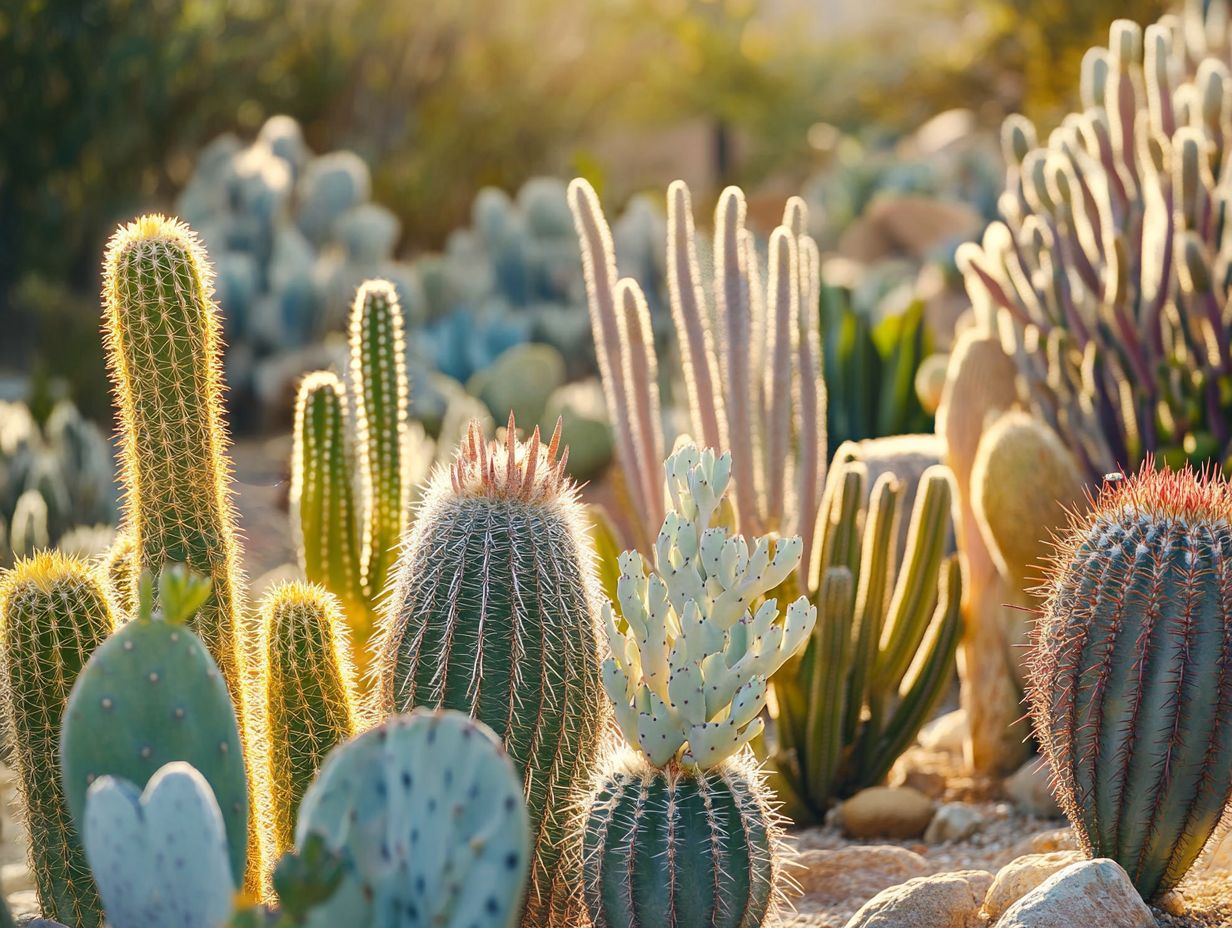
Why Are Cacti Perfect for Drought Gardens?
Cacti varieties perfect for drought gardens typically survive in hot, dry conditions with minimal water and maintenance. To enhance their resilience, it’s crucial to consider choosing the right soil for drought gardens. They often have thick, fleshy stems to store water, along with small or absent leaves to reduce evaporation.
What Are Some Popular Cacti Varieties for Drought Gardens?
- Prickly Pear Cactus
- Golden Barrel Cactus
- Saguaro Cactus
These varieties are known for their ability to thrive in dry, desert-like environments.
How Often Should You Water Cacti Varieties for Drought Gardens?
Cacti varieties perfect for drought gardens typically require watering only once every 1-2 weeks, depending on the climate and specific variety. For enhancing your garden’s resilience, consider using plant companions for drought-tolerant gardens. Watering too frequently can harm these plants, so monitor their water needs carefully.
Are There Special Care Instructions for Cacti Varieties in Drought Gardens?
While these cacti are low-maintenance, ensure they have well-draining soil and are not exposed to extreme temperatures or sudden changes in light. They also benefit from occasional fertilizing using a cactus-specific fertilizer.
Can Cacti Varieties for Drought Gardens Be Grown Indoors?
Yes, some cacti varieties, such as Old Man and Peanut Cactus, can be grown indoors if they have access to bright, indirect sunlight and proper drainage. However, they are best suited for outdoor gardens, where they can receive ample sunlight and airflow.
What Are Other Benefits of Cacti Varieties for Drought Gardens?
Cacti varieties perfect for drought gardens not only require minimal water and maintenance, but they also add unique texture and visual interest to gardens. Incorporating drought-resistant shrubs for low-water gardens can attract pollinators and wildlife, making them a fantastic addition to any sustainable garden design.
Consider trying to plant drought-tolerant cacti in your garden for a sustainable approach and enjoy their unique beauty! For more insights, check out how to choose drought-resistant plants for your garden.

